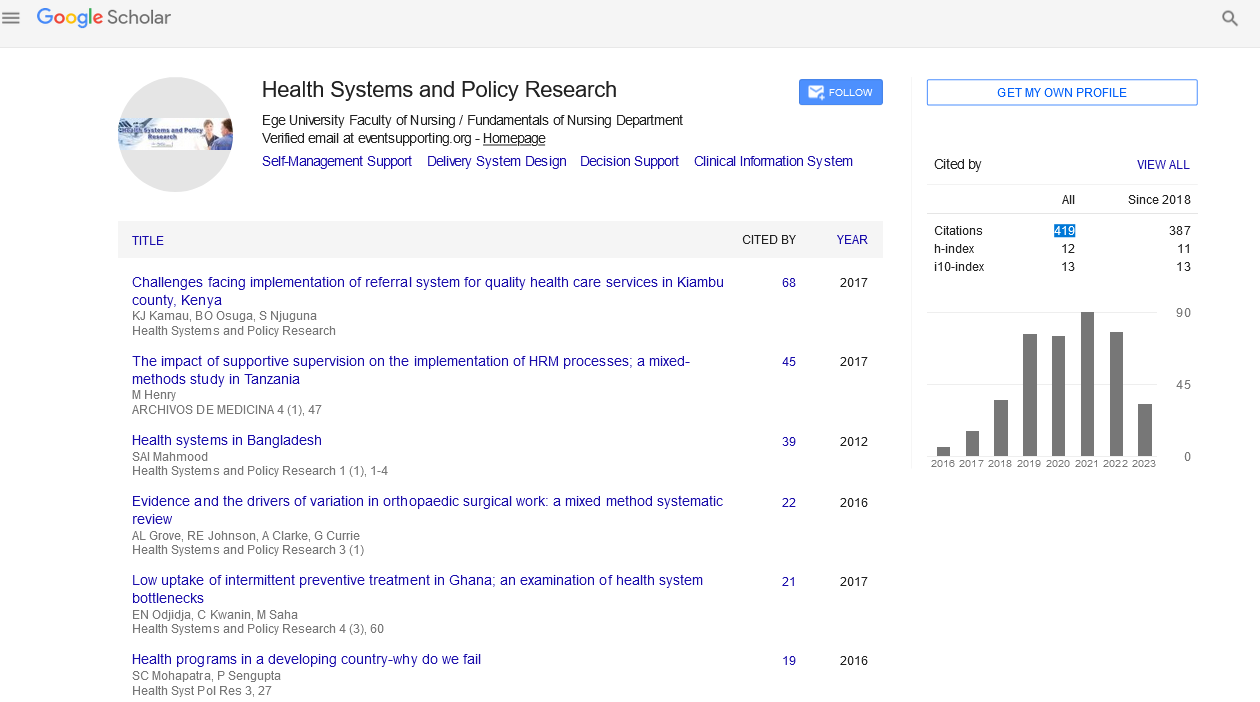Review Article - (2025) Volume 12, Issue 1
Assessing In luenza Activity Variations in the Asian Region during the Pre and Post-Pandemic Period (2019-2023)
Nadia Nisar,
Nazish Badar,
Inayah Safdar,
Bisma Daud,
Najma Javed Awan,
Sumera Naz and
Muhammad Nadeem Asghar*
Department of Medical Biology, University of Quebec, Trois-Rivieres, Canada
*Correspondence:
Muhammad Nadeem Asghar, Department of Medical Biology, University of Quebec, Trois-Rivieres,
Canada,
Email:
Received: 17-Oct-2023, Manuscript No. IPHSPR-23-14108;
Editor assigned: 19-Oct-2023, Pre QC No. IPHSPR-23-14108 (PQ);
Reviewed: 24-Nov-2023, QC No. IPHSPR-23-14108;
Revised: 03-Feb-2025, Manuscript No. IPHSPR-23-14108 (R);
Published:
10-Feb-2025
Abstract
Background: The year 2021 saw a decrease in occasional flu cases across Southeast Asia and the more extensive Asian district. Be that as it may, an unexpected flood in flu cases during 2022-2023 requires a far reaching investigation and examination to illuminate future expectation models.
Objective: Our review plans to assess the illness weight of flu in Asian nations post-Coronavirus, while contrasting occasional varieties with the pre-pandemic flu designs.
Methods: We directed a broad examination of information spreading over from January 2017 to September 2023 across ten Asian nations, sorting them into three WHO districts. Information was obtained from the WHO flunet framework, falling under the domain of the WHO worldwide flu program.
Findings and conclusion: The coming of Coronavirus fundamentally disturbed pre-pandemic flu designs. Restricted information accessibility in the Asian WHO area prompted a few nations having unreported flu seasons. By the by, Coronavirus and flu showed a commonly suppressive relationship during and after the pandemic. Quite, a discernible expansion in flu A subtype cases was distinguished in both the northern and southern halves of the globe, especially in mild zones. These varieties in the flu pattern give significant experiences to foreseeing future flu flare-ups.
Keywords
Flu movement; Asian locale; Post-pandemic; Coronavirus; Illness trouble; WHO worldwide flu program; Flu A subtype; Mild zones; Forecast
Introduction
Flu is an unavoidable respiratory disease that besets populaces around the world. As per the world wellbeing association (WHO) report from January 2023, occasional flu is liable for a yearly cost going from 290,000 to 650,000 passings universally, with the most noteworthy death rate saw among people matured 65 or more. Locales, for example, Southeast Asia and Africa bear the heaviest weight, displaying death rates going from 3.5 to 9.2 per 100,000 people, though the US reports a similarly below death pace of 1.4 per 100,000 people [1].
The development of Coronavirus has uplifted worries about expanded weakness to flu infections, possibly prompting more significant flu episodes around the world. Therefore, proactive measures to foresee occasional flu patterns inside WHO areas have become fundamental [2]. In this review, our goal is to figure varieties in flu movement and give experiences into future occasional patterns across Asian nations, especially following the lifting of Coronavirus limitations in numerous countries.
Post-pandemic, in July 2022, flu type an accomplished a resurgence in Southeast Asian nations, quite Malaysia, the Philippines, and Thailand, suggestive of pre-pandemic movement levels. Despite the fact that flu movement in both the Southern and Northern halves of the globe remained lower than pre Coronavirus levels, it was still strikingly higher contrasted with the pandemic years. By February 2023, nations in East Asia, including Malaysia, Thailand, and Singapore, saw an upsurge in flu action. Worldwide flu action stayed raised as of January 2023, with Pakistan and other South Asian nations revealing a resurgence in flu A (H1N1) pdm09 [3]. Moreover, the co-event of Serious Intense Respiratory Disorder COVID 2 (SARS-CoV-2) and flu was seen in September 2022, driving clinicians to focus on testing for both flu A and B, close by SARS-CoV-2, for high-need patients.
The peculiarity of diminished flu transmission during Coronavirus can be credited to viral obstruction between SARS CoV-2 and the flu infection inside impacted people-an idea initially depicted by the examination gathering of Voroshilova during the 1960’s. Information from the middle for infectious prevention (CDC) upholds this idea, uncovering a decrease in flu rates during the Coronavirus pandemic period, stretching out into spring 2021. Remarkably, Brazil announced just 1.62% of cases as flu positive in 2020. Be that as it may, CDC information for late 2021 to mid-2022 shows tops in flu energy, explicitly in weeks 2, 3, and 14 of 2022 [4].
In mild Asian zones, for example, Pakistan and India, flu encounters tertiary seasons from October to February every year. During top seasons, quick information assessment of flu cases is basic for general wellbeing organizations. Sadly, low-to medium-pay nations frequently need local area based reconnaissance (CBS) or immunization frameworks for high-risk gatherings. The co-discovery of flu and Coronavirus recommends that influenza vaccination might have been impacted, despite the fact that it plays actually had an influence in controlling flu rate to a certain extentxi. Ongoing CDC information likewise shows a 7% increment in influenza immunization rates among the Asian populace as of late. From October 2022 to April 2023, the CDC assessed that flu caused 19,000 to 58,000 passings in the US. Consequently, a worldwide viewpoint on flu spread is fundamental to decide flu subtypes in the midst of the background of Coronavirus. Reconnaissance limit inside Asian nations predicts occasional flu resurgence in thickly populated regions like India, China, and Southeast Asia [5].
The problematic effect of Coronavirus on post-pandemic flu movement has made it trying to decipher flu information during the years 2021-2022. Moreover, flu immunization endeavors in nations like the US have been impacted by Coronavirus inoculation crusades. These variables present vulnerability with respect to future flu scourges, as diminished infection openness and impacted resistance become an integral factor. The occasional pattern of flu has been dysregulated since the finish of the Coronavirus pandemic, suggesting basic conversation starters about future techniques for flu episode control [6].
This study incorporates three WHO districts: Singe (South-East Asia Area), WPR (Western Pacific Locale), and EMR (Eastern Mediterranean Area). Inside Singe, nations like India, Bangladesh, Nepal, Sri Lanka, Thailand, Indonesia, and Myanmar, with a consolidated populace of 687,909,327, assume a urgent part. Pakistan, with a populace of 241,381,224, and Malaysia and the Philippines, with populaces of 33.9 million and 113.9 million separately, contribute essentially to the local scene.
The impact of Coronavirus on flu transmission in the Southern and Northern sides of the equator, especially inside mild Asian districts, stays a continuous secret. In spite of decreased revealing of flu information post-Coronavirus, center Asian nations keep on encountering resurgences, especially including the H3N2 strain [7].
Hence, moderating the gamble of future general wellbeing contaminations during flu flare-ups requires the assortment of information during the Coronavirus pandemic period. The essential goal of our cross-sectional audit is to enlighten the progressions in flu action and its dissemination all through the pre-pandemic, pandemic, and post-pandemic periods. This understanding will educate the advancement regarding preventive projects for impending flu seasons, upheld by nonstop checking of winning flu flare-ups. Dissimilar to past investigations that basically centered around pre-Coronavirus flu spread inside individual nations, our examination envelops different Southern and South-East Asian nations inside WHO locales [8].
Literature Review
Data source
In directing this survey based study, we painstakingly chose ten nations arranged in Southern and Southeast Asia to guarantee an exhaustive portrayal of the district. These nations include Pakistan, India, Bangladesh, Nepal, Sri Lanka, Malaysia, Thailand, Philippines, Myanmar, and Indonesia. The review is organized as a cross-sectional examination, traversing both the pre-pandemic period (2017-2019) and the post-pandemic time frame (2020-2023).
The information used in our examination starts from FluNet reports, which give point by point data in regards to the examples got, examples tried, and the level of positive cases throughout determined time stretches. The World Wellbeing Association (WHO) Worldwide Flu Program fills in as the essential stage for the assortment and examination of this flu observation information. This data is dispersed through FluNet and Liquid by the Worldwide Flu Observation and Reaction Framework (GISRS) in a joint effort with public epidemiological establishments [9]. Outstandingly, this information assortment endured even within the sight of simultaneous investigating Coronavirus cases.
Our review zeroed in on social occasion epidemiological information from every one of the chose nations, explicitly as far as the quantity of examples got, the examples exposed to testing, and the count of flu positive examples. Also, we efficiently gathered information relating to the timing and power of flu action through Liquid flu reconnaissance yields, working with correlations with earlier years' observation information. Influenza Informed Choices (Liquid) filled in as the hotspot for acquiring information concerning flu and Serious Intense Respiratory Disorder (SARS) energy rates, which were in this manner submitted to FLUMART WHO [10].
The information obtained from the six WHO locales, to be specific the African District (AFR), District of the Americas (AMR), Eastern Mediterranean Locale (EMR), European Area (EUR), South-East Asia Area (Burn), and Western Pacific District (WPR), is refreshed consistently. These reports envelop different flu subtypes, including A(H1), A(H1N1) pdm09, A(H3N2), A(H5), A(H7N9), and B subtypes. We remembered all suitable observation frameworks for our review, involving sentinel, non sentinel, and those with vague reconnaissance techniques [11].
It is critical to take note of that every nation contributed information covering different yearly ranges. The gave table shows the flu action of the ten Asian nations during the period from 2017 to 2019, as refreshed on FluNet.
Case definition criteria
WHO case definition for flu like sicknesses is fever with medical clinic confirmation in 10days. Fever which is ≥ 38°C alongside hack and breathing issues is viewed as intense respiratory contamination or SARI [11].
Statistical analysis
Flu movement for every nation by thinking about the level of handled examples that yielded positive outcomes. The nations remembered for our investigation were sorted into two gatherings in view of their geological area inside the Southern or Northern side of the equator [12]. In particular, Indonesia was the sole delegate from the Southern side of the equator, while the excess nine nations were arranged in the Northern half of the globe of Asia. These geological limits crossed from a scope of 77° to a longitude of 195°.
AAPi =ni /∑121 ni
Here, i =month, n=number of cases.
Results
Similar examination for flu action in South and southeast Asian districts shows a raised flu action in Southern Asia with most elevated esteem coming to 878 for flu an in year 2023. Flu A(H1) and B (Yamagat) were seldom announced in Southeast Asia and flu B was seldom revealed in South Asia (Figure 1).
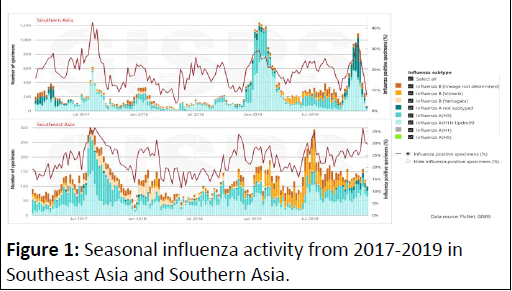
Figure 1: Seasonal influenza activity from 2017-2019 in Southeast Asia and Southern Asia.
Changes in flu action from 2017 to 2023: We got country explicit information on flu movement, the quantity of examples handled, and the energy rate from FluNet for both the pre pandemic and post-pandemic time frames. Our examination covered a sum of 10 nations, with 7 situated in the WHO Singe locale, 1 in the EMR district, and 2 in the WPR area. Across these nations, we recorded a sum of 74,034 instances of flu energy from 2017 to 2023 (Table 1). Figure 2 shows the flu movement in the South and Southeast Asian locale from 2020 to 2023 [12].
| Country |
WHO region |
Specimen received 2017-2019 |
Specimen tested |
Influenza positive specimen |
Specimen received 2020-2023 |
Specimen tested |
Influenza positive specimen |
| Pakistan |
EMR |
8178 |
8178 |
1454 |
51065 |
50832 |
2876 |
| India |
SEAR |
82749 |
81896 |
14898 |
191382 |
191346 |
8621 |
| Bangladesh |
SEAR |
23829 |
22667 |
3651 |
47264 |
41266 |
2761 |
| Nepal |
SEAR |
14196 |
13940 |
5683 |
23682 |
23682 |
3184 |
| Sri Lanka |
SEAR |
3820 |
14326 |
4532 |
3753 |
5069 |
706 |
| Malaysia |
WPR |
16514 |
16232 |
2364 |
77242 |
76332 |
11309 |
| Thailand |
SEAR |
11881 |
11881 |
3641 |
19709 |
19711 |
1609 |
| Indonesia |
SEAR |
7804 |
7804 |
2277 |
4686 |
4675 |
1207 |
| Philippines |
WPR |
5785 |
5779 |
1096 |
8559 |
8559 |
714 |
| Myanmar |
SEAR |
3463 |
3464 |
1339 |
927 |
927 |
112 |
Table 1: Comparison of ten Asian countries with pre and post-pandemic influenza activity sources through Flunet.
Huge occasional changes in flu action are apparent in the Southeast Asia Locale (Singe), Western Pacific District (WPR), and Eastern Mediterranean District (EMR), as portrayed in Figures 2 and 3. The review enveloped recently revealed instances of Coronavirus across each of the three WHO areas from 2020 to 2023 [13].
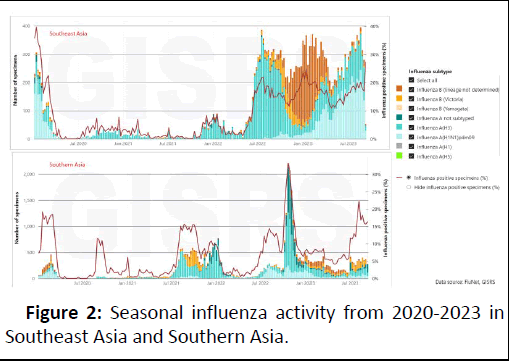
Figure 2: Seasonal influenza activity from 2020-2023 in Southeast Asia and Southern Asia.
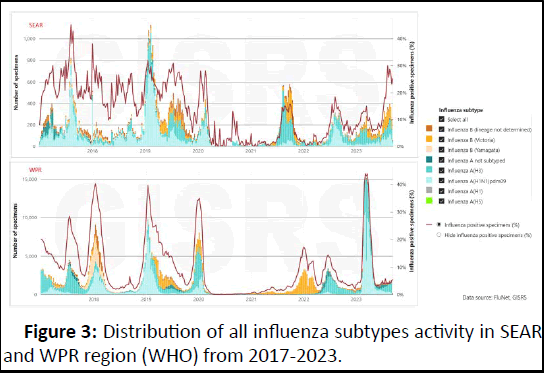
Figure 3: Distribution of all influenza subtypes activity in SEAR and WPR region (WHO) from 2017-2023.
In 2020, a prominent lessening in flu movement was noted in the WPR district, where Coronavirus was at first identified and answered to the WHO.
Moving into 2021, flu movement remained reliably low, remaining beneath 10% in both the Burn and WPR locales.
Notwithstanding, by 2022, a noticeable expansion in flu action was seen in both the Singe and WPR locales, with the Burn district enrolling levels surpassing 70%. Notwithstanding this ascent, flu action in the WPR area remained lower than pre Coronavirus levels [14].
Prominently, in the WPR district, the event of Coronavirus cases declined in January 2023, harmonizing with a perceptible resurgence in flu throughout the spring of 2023, arriving at levels as high as 15%.
The period from 2022 to 2023 saw an arrival of flu action to levels similar to those saw in 2017 and 2018.
The examination of flu plagues' length, led utilizing the AAP technique, uncovered that before the Coronavirus pandemic period (2017-2019), flu scourges ordinarily happened from July through January [15].
Nonetheless, there was a perceptible change in the example in July 2021 when the flu season started at a lower force. Hence, it saw a resurgence in January 2022, as portrayed in Figures 2 and 3.
This change in the planning of flu pestilences in the post Coronavirus period seems to shift across areas, potentially impacted by hemispheric contrasts.
Discussion
In this audit, we portray examples of flu action and its varieties alongside subtypes from 2017-2023 with center around Asian area. Flu A (H1N1) has forever been predominant in both pre and post-Coronavirus period in all WHO districts. During the pandemic flu action was brought down in all nations in 2020-2021 when Coronavirus cases were accounted for at top. Intriguing flu B yamagata cases were accounted for during pandemic [16,17]. Southeast Asian Locale and West Pacific Districts showed an assortment in flu term as WPR locales previously revealed Coronavirus cases in 2020. As given the progressions of flu pestilences after Coronavirus, flu immunization should be acquainted with increment invulnerability for any episode (Figure 4).
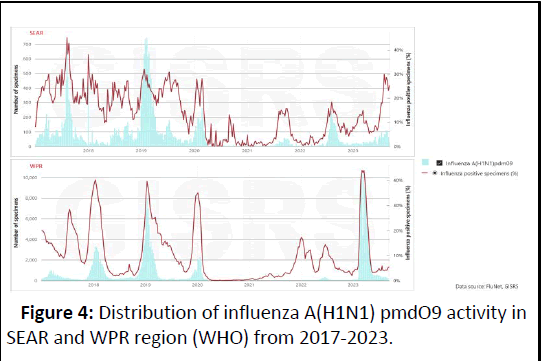
Figure 4: Distribution of influenza A(H1N1) pmdO9 activity in SEAR and WPR region (WHO) from 2017-2023.
Numerous past examinations previously anticipated an ascent in contamination trouble because of flu in 2022-2023. The review assessed a recuperated pace of flu in later seasons. Thusly, the effect on next seasons will rely upon the span influence and recuperated extent of flu post Coronavirus period. Past examinations have assessed an ascent in future flu flare-ups regarding 2017-2019 flu rate.
Early exploration completed assessed a decrease of 60% in disease rate in US inside a ten weeks' time span. Numerous non drug mediations as well as antibodies assumed part to carry flu to base level during 2020. The event of flu and Coronavirus pave the way to 25% decrease in flu rate during winter season. Many review models anticipated a 1-4-overlay ascend in flu plague in 2023. Thus, absence of openness to flu during 2020 can prompt feeble resistance in forthcoming seasons. A review dissected unimportant neutralizer creation against flu in 2020. Dissecting past flu patterns with post-Coronavirus patterns will assist with anticipating future occasional timings. However, these motions can't be precisely estimated because of absence of information in post-pandemic period.
In our noticed nations and their information, winter of 2022 and January of 2023 had a higher positive rate for flu cases similar to earlier years. We had a constraint of post Coronavirus t ime span sue to restricted information however the accessible information can show the expanded pattern of flu action.
Commonness of flu in Pakistan is 24% and generally cases are accounted for from Punjab. Pakistan had predominant flu season in August-October. There is wide variety both between nations with their information submitted, be that as it may, scarcely any years' information from every nation was unreported, various nations had different testing and wellspring of information submitted to Flunet.
October 2022 had diminished detailing for sentinel instances of Coronavirus, while flu continued to increment in Southeast Asia with flu A subtypes being transcendent. In September October 2022, WHO GISRS research facilities tried in excess of 133 934 examples out of which 5323 were tried positive for flu.
The prescient models utilized in the audit depended on the flu and flu subtypes for every country, which was not uniform across the nations which may be because of various information assortment strategies in Coronavirus pandemic during 2020 and 2021. Hence, country explicit information for Asian areas was not recovered. This might have given more understanding into future patterns. Second, our model decides the impact of Coronavirus and expanded defenselessness to flu in impending seasons because of antigenic changes. Our review showed the shortfall of occasional flu during Coronavirus pandemic which gives proof to past examinations asserting brought down resistance in people post Coronavirus pandemic. This will likewise influence the expectation models for the beginning of occasional flu. Besides, this study didn't investigate the impact the of Coronavirus immunization on flu, which likewise an element for flu trouble. Our review shows that expectation of pinnacle timing for occasional flu before time is significant, in light of the fact that mild locales are supposed to encounter flu tops affected by ecological and resistance factors. Despite the fact that flu B spreads round the year in most tropical locales of southern and south-east Asia, the best time for flu immunization as per latest WHO suggested immunization would be before the storm season going for the gold flu An and B tops. Our finding prescribes to go to proactive lengths to alleviate the wellbeing trouble.
Concentrate on features a critical drop in flu cases during 2021 followed by an unexpected expansion in 2022-2023, showing a possible future example of swaying among flu and Coronavirus like viral sicknesses. These patterns can act as early markers during flu seasons, offering important bits of knowledge for general wellbeing administrative specialists to proactively configuration programs pointed toward expanding flu vaccination rates.
While it's vital to take note of that our information may not completely address the sickness trouble present pandemic due on restricted detailing from certain nations to the WHO, it gives an all encompassing perspective on the current circumstance and its expected outcomes. Past examinations have frequently underrated the genuine flu trouble, fundamentally depending on information from the WHO with restricted detailing elements. Interestingly, our review gives a quantitative evaluation of flu variety utilizing both month to month and yearly information, which can act as a significant instrument for directing reconnaissance and intercession procedures.
Conclusion
All in all, our survey based examination makes us aware of the probability of an extensive flu trouble in forthcoming seasons. Executing flu immunization programs and advancing inoculation among the two kids and grown-ups can assume a vital part in moderating the double weight of flu in the post-Coronavirus period.
Limitations
It's important to acknowledge the limitations of our cross sectional assessment. Firstly, the reliability of our findings may be affected by the availability of data, as certain WHO regions lacked data for specific influenza subtypes such as AH5 and subtype B. Additionally, there were data gaps for many countries during the COVID-19 season, which could impact the comprehensiveness of our analysis.
Furthermore, we encountered limitations related to the absence of seasonal charts for the Southeast Asian regions, including Pakistan, spanning the period from 2019 to 2023. Lastly, it's essential to recognize that our study focused exclusively on reviewing influenza activity within Asian countries, which may not provide a complete global perspective on the subject.
Ethics Declarations
Ethics approval and consent to participate.
Our study was conducted using collected data. There was no direct involvement of participants in study design, recruitment or conduct of the study.
Conflict of Interest
There is conflict of interest between the author and any coauthor of this article.
Data Availability Statement
All relevant data within the paper tables and figure files is available on WHO FluNet and FluID. However, the interpretation and conclusions contained in this report are those of the author/s alone.
Acknowledgments
The authors are grateful to the World Health Organization, for availability and free access to the global data for influenza and virus surveillance. The data are provided remotely by National Influenza Centers (NICs) of the Global Influenza Surveillance and Response System (GISRS) and other national influenza reference laboratories collaborating actively with GISRS.
Transparency Declaration
The lead author affirms that the manuscript is an honest, accurate, and transparent account of the study being reported; that no important aspects of the study have been omitted; and that any discrepancies from the study as originally planned have been explained.
Funding Source
We do not have any funding support to publish this study.
Competing Interests
The authors declare that they have no known competing f inancial interests or personal interests.
References
- WHO (2023) Influenza-seasonal. WHO
- Malik YA (2023) Impact of influenza in south-east Asia. Int J Infect Dis 130:S40-S41
[Crossref] [Google Scholar]
- Gao H, Du Z, Tsang TK, Xiao J, Shan S, et al. (2021) Pandemic fatigue and attenuated impact of avoidance behaviours against COVID-19 transmission in Hong Kong by cross-sectional telephone surveys. BMJ Open 11:e055909
[Crossref] [Google Scholar] [PubMed]
- Safdar I, Nisar N, Awan NJ, Badar N, Naz S, et al. (2023) Assessing influenza activity variations in the Asian region during the pre-and post-pandemic period (2019-2023)
[Crossref] [Google Scholar]
- Ravikumar S, Tamboli E, Rahangdale S, Salsekar L, Tomar SS, et al. (2023) Dynamics of Influenza A and SARS-CoV-2 coinfections during the COVID-19 pandemic in India. medRxiv 22:2023-2002
[Google Scholar]
- Stowe J, Tessier E, Zhao H, Guy R, Muller-Pebody B, et al. (2021) Interactions between SARS-CoV-2 and influenza, and the impact of coinfection on disease severity: A test-negative design. Int J Epidemiol 50:1124-1133
[Crossref] [Google Scholar] [PubMed]
- Voroshilova MK (1989) Potential use of nonpathogenic enteroviruses for control of human disease. Prog Med Virol 36:191-202
[Google Scholar] [PubMed]
- Deleveaux S, Clarke-Kregor A, Fonseca-Fuentes X, Mekhaiel E (2023) Exploring the possible phenomenon of viral interference between the novel coronavirus and common respiratory viruses. J Patient Cent Res Rev 10:91
[Crossref] [Google Scholar] [PubMed]
- Deleveaux S, Clarke-Kregor A, Fonseca-Fuentes X, Mekhaiel E (2023) Exploring the possible phenomenon of viral interference between the novel coronavirus and common respiratory viruses. J Patient Cent Res Rev 10:91
[Crossref] [Google Scholar] [PubMed]
- Sullivan SG, Carlson S, Cheng AC, Chilver MB, Dwyer DE, et al. (2020) Where has all the influenza gone? The impact of COVID-19 on the circulation of influenza and other respiratory viruses, Australia, March to September 2020. Eurosurveillance 25:2001847
[Crossref] [Google Scholar] [PubMed]
- Dhanasekaran V, Sullivan S, Edwards KM, Xie R, Khvorov A, et al. (2022) Human seasonal influenza under COVID-19 and the potential consequences of influenza lineage elimination. Nat Commun 13:1721
[Crossref] [Google Scholar] [PubMed]
- Maltezou HC, Medic S, Cassimos DC, Effraimidou E, Poland GA (2022) Decreasing routine vaccination rates in children in the COVID-19 era. Vaccine 40:2525
[Crossref] [Google Scholar] [PubMed]
- Achdout H, Vitner EB, Politi B, Melamed S, Yahalom-Ronen Y, et al. (2021) Increased lethality in influenza and SARS-CoV-2 coinfection is prevented by influenza immunity but not SARS-CoV-2 immunity. Nat Commun 12:5819
[Crossref] [Google Scholar] [PubMed]
- Lee SS, Viboud C, Petersen E (2022) Understanding the rebound of influenza in the post COVID-19 pandemic period holds important clues for epidemiology and control. Int J Infect Dis 122:1002-1004
[Crossref] [Google Scholar] [PubMed]
- Taubenberger JK, Morens DM (2010) Influenza: The once and future pandemic. Public Health Rep 125:15-26 [Crossref]
[Google Scholar] [PubMed]
- Zeng L, Zang F, Song N, Li Z (2022) Analysis of influenza trend and impact of COVIDâ?19 in Kezhou, Xinjiang for 8 consecutive years. J Med Virol 94:3081-3086
[Crossref] [Google Scholar] [PubMed]
- Shaman J, Pitzer VE, Viboud C, Grenfell BT, Lipsitch M (2010) Absolute humidity and the seasonal onset of influenza in the continental United States. PLoS Biol 8:e1000316
[Crossref] [Google Scholar] [PubMed]
Citation: Nisar N, Badar N, Safdar I, Daud B, Awan NJ, et al. (2025) Assessing Influenza Activity Variations in the Asian Region during the Pre and
Post-Pandemic Period (2019-2023). Health Syst Policy Res Vol:12 No:1





